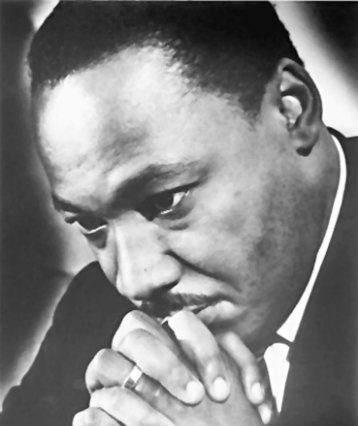Introduction
After Rosa Parks’ arrest and conviction, in 1955, for refusing to give up her seat on a bus to a white passenger, the black citizens of Montgomery Alabama, under King’s leadership, began a boycott of the city’s buses in order to protest the law requiring racial segregation on public transportation. The boycott, perfectly legal, lasted for over a year until after the Supreme Court, in late 1956, upheld a lower court’s decision that had ruled the city’s segregationist laws unconstitutional. This victory for the combined approach of legal challenge and peaceful public protest was one of the first successful applications of King’s teaching and strategy of nonviolent resistance. On June 4, 1957, at the invitation of the local YMCA and YWCA, King gave this speech at the University of California at Berkeley, in which he explained the philosophy and strategy of nonviolence. (As an appendix to King’s speech, we add the text of the “Commitment Card,” prepared by the Alabama Christian Movement for Human Rights, on which Movement members pledged their adherence to the principles of nonviolence.)
King says that the method of nonviolent resistance is “strongly aggressive spiritually”? What does he mean by “spiritual aggression,” and why is it morally not only acceptable but required? What are the aims of practicing nonviolent resistance, both for the opponent and for oneself? King argues that the philosophy of nonviolent resistance has at its center the teaching of love understood as agape: “understanding, creative, redemptive good will for all men . . . an overflowing love which seeks nothing in return.” How, in fact, does such love translate itself into action? If people are the authors of their deeds and responsible for their actions, can we really love a person unconditionally while, at the same time, hating the deeds that he does? How does King distinguish good moderation from bad moderation? Is it always possible, in concrete cases, to distinguish which is which?
From the very beginning there was a philosophy undergirding the Montgomery boycott, the philosophy of nonviolent resistance. There was always the problem of getting this method over because it didn’t make sense to most of the people in the beginning. We had to use our mass meetings to explain nonviolence to a community of people who had never heard of the philosophy and in many instances were not sympathetic with it. We had meetings twice a week on Mondays and on Thursdays, and we had an institute on nonviolence and social change. We had to make it clear that nonviolent resistance is not a method of cowardice. It does resist. It is not a method of stagnant passivity and deadening complacency. The nonviolent resister is just as opposed to the evil that he is standing against as the violent resister but he resists without violence. This method is nonaggressive physically but strongly aggressive spiritually.
Click here to read the rest of the speech.
* * *
Appendix: “Commitment Card”
Alabama Christian Movement for Human Rights
I hereby pledge myself—my person and body—to the nonviolent movement. Therefore I will keep the following ten commandments:
- Meditate daily on the teachings and life of Jesus.
- Remember always that the nonviolent movement seeks justice and reconciliation—not victory.
- Walk and talk in the manner of love, for God is love.
- Pray daily to be used by God in order that all men might be free.
- Sacrifice personal wishes in order that all men might be free.
- Observe with both friend and foe the ordinary rules of courtesy.
- Seek to perform regular service for others and for the world.
- Refrain from the violence of fist, tongue, or heart.
- Strive to be in good spiritual and bodily health.
- Follow the directions of the movement and of the captain on a demonstration.
I sign this pledge, having seriously considered what I do and with the determination and will to persevere.
Name____________________
Address__________________
Phone___________________
Nearest Relative___________
Address__________________
Besides demonstrations, I could also help the movement by: (Circle the proper items)
Run errands, Drive my car, Fix food for volunteers, Clerical work, Make phone calls, Answer phones, Mimeograph, Type, Print signs, Distribute leaflets.
ALABAMA CHRISTIAN MOVEMENT FOR HUMAN RIGHTS
Birmingham Affiliate of S.C.L.C.
505 1/2 North 17th Street
F.L. Shuttlesworth, President
Return to The Meaning of Martin Luther King Jr. Day.




Post a Comment